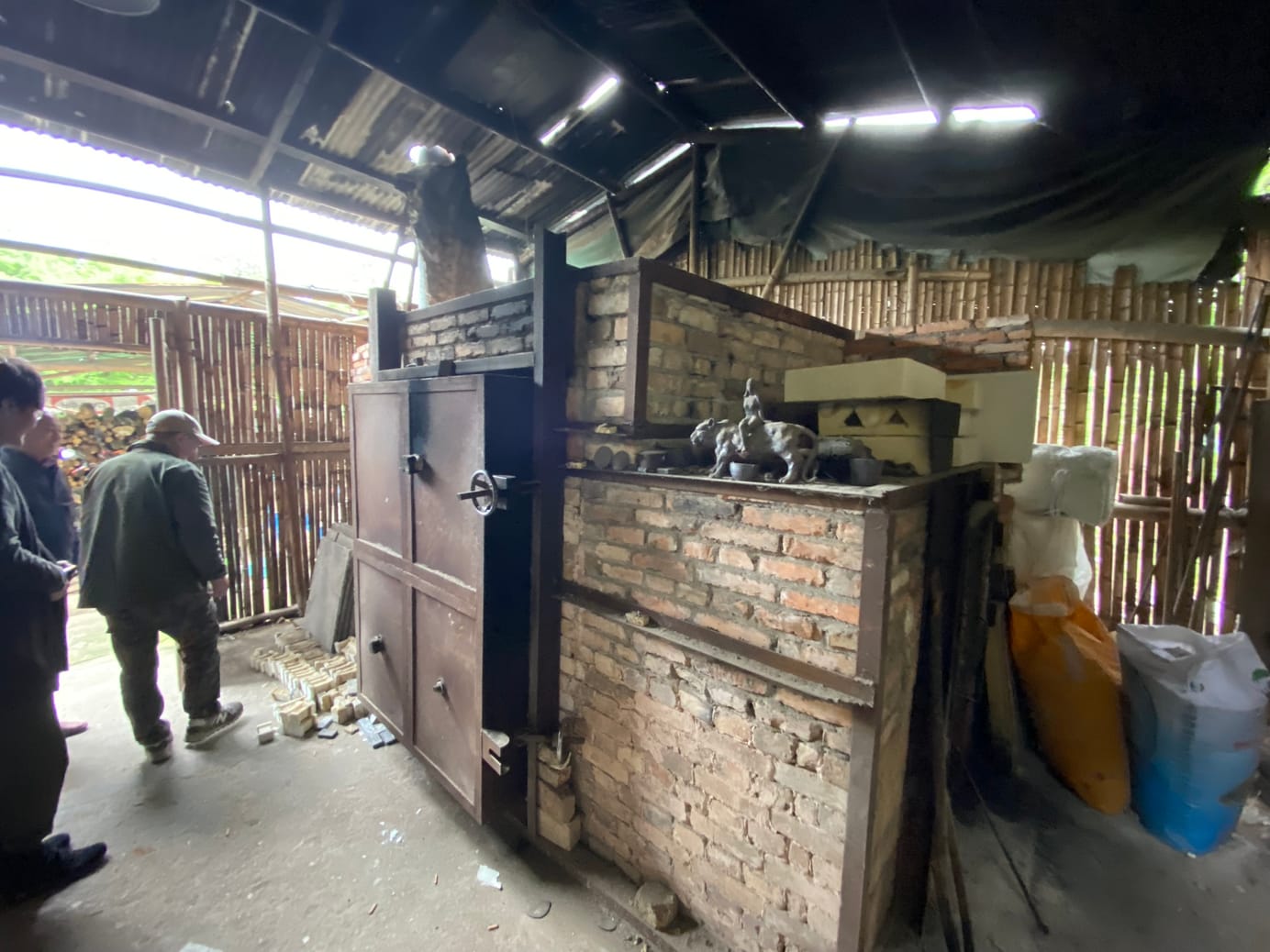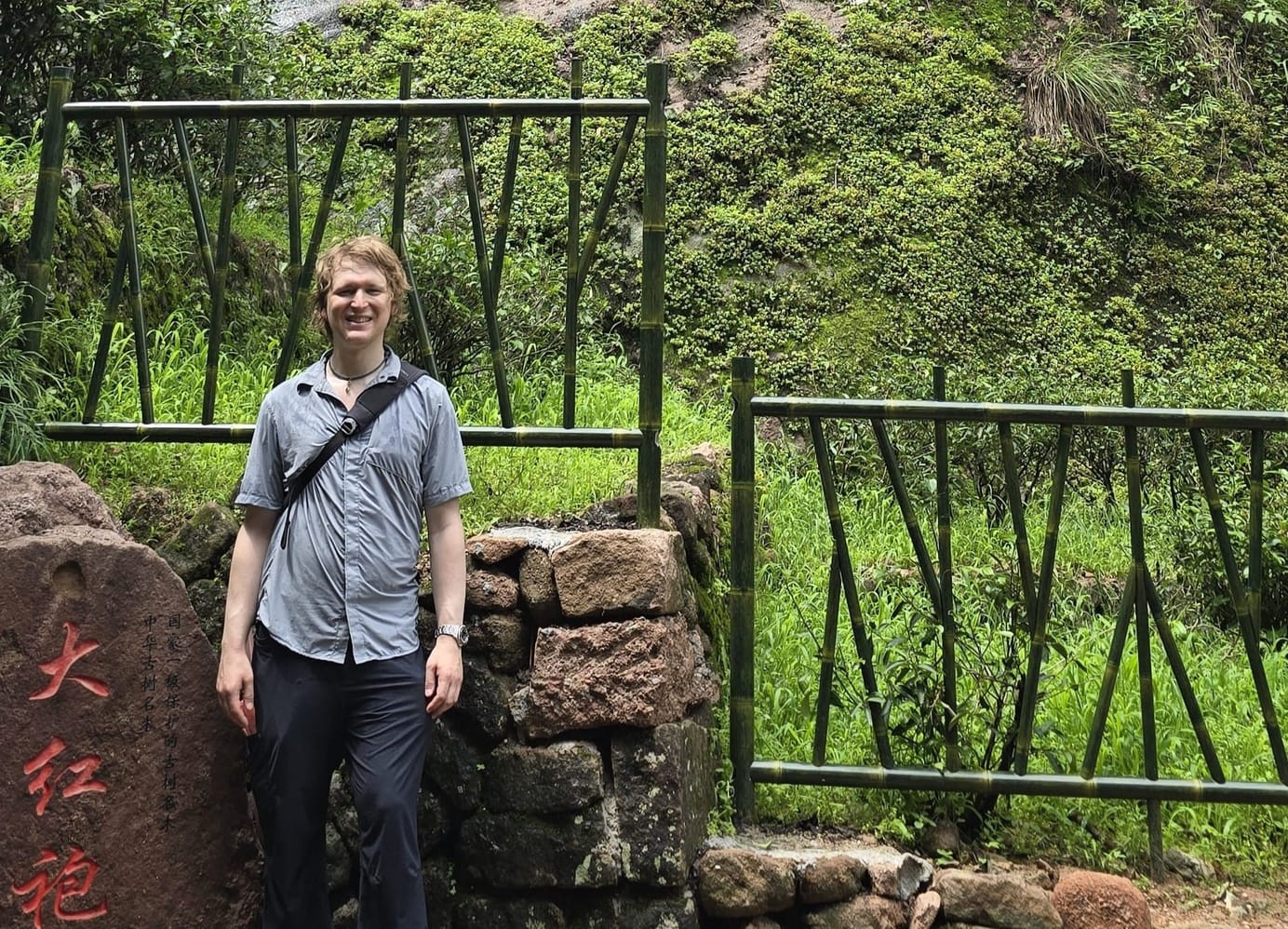
Editorial Conversation: Chapter 10, Section 4: Downdraft Kilns (倒焰窑)
The episode is also available on YouTube and Spotify.
A full transcript is included on the episode page and below:
[00:00:05] Jason Cohen: Hello everyone. I'm Jason Cohen, the author of an Introduction to the Art and Science of Chinese Tea Ceremony. Today we're discussing book two, chapter 10, section three, Downdraft Kilns. Here to talk about this chapter is our editorial team, Zongjun Li.
[00:00:19] Zongjun Li: Hello, hello.
[00:00:21] Jason Cohen: And Emily Huang.
[00:00:23] Emily Huang: Hi everyone.
[00:00:24] Jason Cohen: Wonderful. My first question, what is a downdraft kiln?
[00:00:30] Emily Huang: A down draft kiln is a kiln that, maybe you can get it from its name, where the chimneys are located instead on the top of the kilns, it is towards the bottom. And so that the air is circulated in a way that it comes in from below up into the inside of the kiln and then down again.
[00:00:55] Zongjun Li: Yeah, you can basically envision it as a compressed version of a dragon kiln. It still retains a lot of similar structure as a dragon kiln, and it used the chimney to create a suction of air to create an airflow inside the kiln to fire the wares inside.
[00:01:16] Jason Cohen: I guess the important thing about the downdraft kiln is as Emily said the chimney is at the bottom. So you actually have a firing box at the bottom and the heat has to flow up and it has to fill the entire chamber in order to exit the chimney at the bottom. So you could envision the kiln as a U where the heat flows from the front of the U up into the kiln and then down through the chimney. So,
[00:01:43] Zongjun Li: That's right.
[00:01:44] Jason Cohen: The key insight into what a downdraft kiln is. What is the advantage of the chimney at the bottom. Is there an advantage? What, what is the purpose of that technology versus a, a top chimney?
[00:01:56] Emily Huang: There are a few advantages for this type of downdraft, and one being as Jason mentioned, it creates a more condensed airflow. It provides a little bit more of a efficiency compared to previous kiln types such as dragon kilns.
[00:02:14] Jason Cohen: It's slightly less fuel efficient then other types of kilns because it radiates away much of the heat. But it uses far less fuel per firing. And the stability of the heat is very high, although there is a top to bottom gradient in the overall heat.
[00:02:35] Zongjun Li: Yeah, that is correct. And also for such construction, you can really condense the space required to build a kiln to fired a larger amount of wares. And the structure is fairly simple to build and it really allows the chamber to create a more homogeneous and stabled temperature across all of the sections, although you still would have a gradient of temperature from top to bottom. The Chinese name for downdraft kiln literally means upside down flame kiln. You have the flame coming from top to bottom instead of coming from each side like tunnel kiln or a gas kiln or electric kiln. Very interesting kiln type if you look into it. Although it not as fuel efficient. It, it's much smaller kiln. So it doesn't necessarily require significant amount of fuel source.
[00:03:29] Jason Cohen: Where did this, the, the design of the downdraft kilns originate in China? Were downdraft kilns developed in Yixing ex novo, or was there inspiration from other ceramic centers aiding the design of the Yixing's downdraft kilns.
[00:03:44] Emily Huang: So the design of downdraft kilns did not originate from Yixing. It were based on another type called mantou yao, which can be translated to steam bun type kilns, and probably more in the northern China areas and probably even back earlier to the Warring States Period, which is about 475 BC to 221 BC
[00:04:14] Zongjun Li: Yeah, the mantou prototype mantou yao really looks kind of like some of the wood fire pizza burner that you see in the west. But it, it was originally from that shape and then refined during the Northern Song dynasty.
[00:04:29] Jason Cohen: Which brings me to the most important question of this podcast. Charcoal pizza or woodfire pizza?
[00:04:34] Zongjun Li: Woodfire. No. Heavy oil burnt pizza.
[00:04:39] Jason Cohen: It's not a heavy oil kiln. They gotta burn that olive oil.
[00:04:43] Zongjun Li: Excessive taste of grease. The petroleum flavor. It's much better than truffle. Yeah.
[00:04:49] Jason Cohen: No need for truffle oil if you use a heavy oil kiln for your pizza.
When were downdraft kilns first used in Yixing? And why were they only used for about two decades during the F1 period?
[00:05:01] Emily Huang: So the downdraft kilns entered Yixing about mid to late 1950s, and it was adopted because it basically can burn anything. And it was during a time when craftsmen were facing a lot of fuel shortages. So they were not just burning wood. They were burning coal or oil and anything they can think of. And it works for downdraft kilns. But slowly they realized this is not quite efficient fuel wise, and it was not very clean. And they were developing and realizing other better technologies, better ways to burn. So it slowly faded.
[00:05:47] Jason Cohen: What was the quality of the zisha wares fired in a downdraft kiln?
[00:05:53] Emily Huang: As we mentioned earlier, because there were a range of different types of fuel sources it really created a lot of dust and it was just not clean. There were things in the dust or ashes that could remain on the wares. To be honest the zisha wares that were produced in downdraft kilns, especially in the earlier periods of downdraft kilns adoptions were not very good.
[00:06:20] Zongjun Li: Yeah. So, even though there's a relatively stable temperature overall, there's quite a difference between the top stack versus the bottom stack. So, when people are trying to figure out exactly how to use the kiln, along the way many flaws and crackage exist and also, the mixed use of different fuel source really create a lot of smoke. Not very high quality wares.
[00:06:45] Jason Cohen: A lot of surface blemishes.
[00:06:48] Zongjun Li: Yeah.
[00:06:49] Jason Cohen: And yet people still are all over collecting F1. Do these surface blemishes have an effect on the tea or are these just aesthetic?
[00:06:59] Zongjun Li: It's like people still collect very early Chloe Sauv whiskey, you know, like it's a part of the legend, but not necessarily high quality. Yeah.
[00:07:11] Jason Cohen: In this chapter I write that historically downdraft kilns were transitory technology in the progression of kiln use in Yixing. So if the wares were lower quality and if they were eventually abandoned, why has there recently been a reemergence of downdraft kilns as the leading, really the only kiln design for wood-fired wares of zisha material?
[00:07:35] Zongjun Li: Very interestingly, we actually physically visit one of the downdraft kiln, wood-fired downdraft kiln in our last Yixing trip. And what we learned is that first of all it's not necessarily legal to burn wood in Yixing. Except from the once a year ceremonially fired dragon Kiln in Yixing, you don't technically allowed to burn wood in other places. So downdraft kiln is really a good middle ground because it's pretty small, so it doesn't really attract a lot of attention. We drove about half an hour in to the mountain to our friend's studio to visit his site. It's quite interesting.
Wood-fired kiln, wood-fired wares has this like irreplaceable charm to me. The warmth, the weight, the gravity in your hand, the interesting surface texture that it creates. It has a lot of merits. Nowadays people who owns and fired downdraft kilns in Yixing use high quality fuel source. And they have the mechanism and the technology of using such kiln perfected over the years. So, it's no longer such a stumbled process to fire wares in downdraft kiln anymore. And for the wares that we have seen and end up purchasing some, they're quite beautiful and quite nice to use.
[00:09:00] Jason Cohen: So in summary, we've returned to downdraft kilns because they're small, they're compact, they can be placed up in the mountains. The officials who like tea and like Yixing, is why they oversee it, also appreciate wood-fired wares. You can do small amounts of firing with high quality fuel sources. So really the issue with the downdraft kilns wasn't the kiln technology itself. This is a, a continuation of the issues during the communist period of deforestation, the lack of high quality fuel sources.
[00:09:31] Zongjun Li: Yeah, exactly. I mean, garbage in, garbage out. Can't expect high quality wares coming from low quality fuel source.
[00:09:40] Jason Cohen: Earlier in this discussion we had mentioned the issues of ash and dust and ware breakage. Do we find that ware breakage is still high in downdraft kiln? Has there been a continuous progression in this technology so that there's now less ash and dust and there's less breakage? Or are Yixing artists today resign to wood-fired wares sell at a little bit of a higher price because there's going to be more, more breakage and flaws?
[00:10:13] Zongjun Li: Interesting question. So, what we have learned is that for a lot of artists they don't necessarily use downdraft kiln throughout. Sometimes the wares will be fired in a electric kiln once, and then it gets the second fire. First it went through a zhengkou, the mouth adjustment process, and then they get re-fired in a wood kiln, a downdraft kiln to receive the, the surface finish or the texture finish. So that's I guess one way to prevent intensive crack issue. And also, higher quality fuel source and better control of the temperature also really helps. And nowadays they also adopted very interesting material to insulate the kiln. It's asbestos? Yeah. Asbestos. How safe they are, I don't know. But they do, they, they do do a good job in the insulating the heat radiating from the kiln.
[00:11:06] Jason Cohen: That was a little concerning seeing the kiln entirely lined with asbestos. Well, none of us have developed mesothelioma yet. I guess we're okay.
[00:11:19] Zongjun Li: Yeah, it was pretty, pretty interesting visiting that site. I missed that place.
[00:11:24] Jason Cohen: So Yixing had a history of firing other wares, including Yijun, of course, but these kilns that were originally from Northern China weren't originally used for zisha. They were originally used for other ceramic art forms. Was there any history of those art forms entering Yixing with the spread of these kilns?
[00:11:47] Emily Huang: So along with the shape from mantou kilns that originated from the Northern China region, the intended ware that it was originally designed for were some celadon wares, especially glazed ones. And so that also came along and entered into Yixing.
[00:12:10] Jason Cohen: So there was a late blossoming of celadon wares in Yixing for a short period of time. Have we ever seen any Yixing celadon wares? Are there any pieces in museums or anything? And is there any contemporary production of this?
[00:12:25] Zongjun Li: We've seen a few pieces in the Yixing Ceramic Museum in the Yixing Town. But as the demand of zisha really thrived, a lot of these studios stopped producing all kinds of other wares except zisha, which is kind of sad to see, like, Yijun, celadon and there used to be a very large production of other daily usage ware too. I think we heard of one of the artists talking about like Yixing being a major ceramic tiles production region back in the days. But now it's mostly
[00:13:01] Jason Cohen: Here we can mention the Yixing ceramic tiles and the Starbucks.
[00:13:05] Zongjun Li: Yeah. That was very cool. I, I don't know if Emily,
[00:13:08] Emily Huang: No.
[00:13:09] Zongjun Li: Okay.
[00:13:10] Emily Huang: Do tell.
[00:13:10] Zongjun Li: Yeah. Yeah. Very interesting. It's Blue Bottle opened a bunch of new chains in China. Personally I think the quality of Blue Bottle in China is significantly better than the ones in the States. I think Jason will agree with me.
[00:13:24] Jason Cohen: Different supply chain?
[00:13:25] Zongjun Li: Yeah, different supply chain. And one of their flagship cafe in Shanghai they use I think some 5,000 pieces of ceramic tiles all fired using zisha and
[00:13:40] Emily Huang: Wow.
[00:13:41] Zongjun Li: Yeah. And they installed them on the floor, on the wall, on the ceiling. Oh, it's quite beautiful.
[00:13:47] Emily Huang: Wow.
[00:13:47] Zongjun Li: Very cool. Yeah, very cool to see
[00:13:49] Emily Huang: Googling that.
[00:13:50] Zongjun Li: Yeah. Well, if our listeners had the chance to visit Shanghai, please do visit that Blue Bottle in Kerry Centre.
[00:13:58] Jason Cohen: That's great. This top,
[00:13:58] Zongjun Li: It's not a paid advertisement.
[00:14:01] Emily Huang: But we welcome paid advertisement.
[00:14:03] Zongjun Li: We do, we do.
[00:14:06] Jason Cohen: Blue Bottle.
[00:14:07] Zongjun Li: Nestle.
[00:14:09] Jason Cohen: Alright everyone, that's all the time that we have for today. Thank you for joining us in this edition of Tea Technique Editorial Conversations. Please join us again for our next conversation, Tunnel Kilns.


